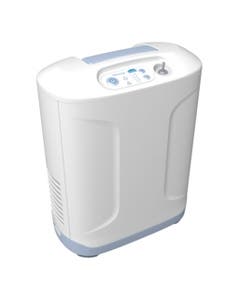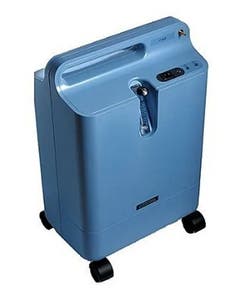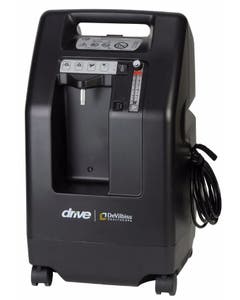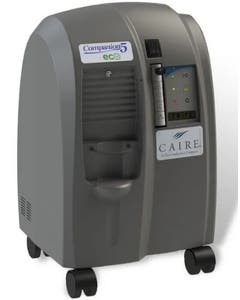During a typical day, the average person breathes nearly 25,000 times1 without thinking much about it. But, not everyone is breathing easy. For those suffering from respiratory ailments that require a regular supply of supplemental oxygen, each breath matters. A home oxygen concentrator (HOC) is the preferred solution for delivering that necessary flow of oxygen in the comfort of your own home. With a home oxygen concentrator, you no longer need tank refills or replacement oxygen tanks. HOCs are an effective alternative to providing oxygen more easily and more comfortably.
How does a Home Oxygen Concentrator Work?
HOCs do not require a supply of oxygen. Instead, they convert the air in your home into oxygen. Air is taken in and compressed. The HOC removes nitrogen, then pure oxygen is delivered through a mask, or an oxygen delivery device called a nasal cannula.
Who Needs Home Oxygen Concentrators?
HOCs are recommended by doctors when the level of oxygen in your blood is low. HOCs may be used for short-term treatments in conditions like asthma or pneumonia or for long-term care for chronic conditions like COPD.
Choosing a Home Oxygen Concentrator
With so many options of HOCs available, the best place to start when selecting a home oxygen concentrator is by asking yourself a few simple questions.
How much oxygen do you need?
Some respiratory conditions may require a high capacity flow of oxygen up to 10LPM (liters per minute). In other instances, a lower LPM may be enough. Your doctor’s prescription will determine the LPM you need.
What size home oxygen concentrator should you get?
If home space is limited, consider a more compact HOC. These models are more lightweight, weighing as little as 18 lbs. Often set on casters for effortless mobility, individuals can easily move the HOC by themselves. However, if you travel frequently, you may want to consider a portable oxygen concentrator.
Easy to Use
You want a home oxygen concentrator that isn’t complicated. Look for designs that feature a simple and easy to understand control panel. Energy efficiency and quiet performance are also essential features if you use your HOC often.
When you need an LPM between 1 and 5, two lightweight, easy to use models stand out.
Inogen At Home Stationary Oxygen Concentrator
Weighing only 18 pounds, the Inogen is an ideal home unit. The Inogen delivers up to 5 LPM of continuous flow oxygen at low power, so it saves on the electric bill.
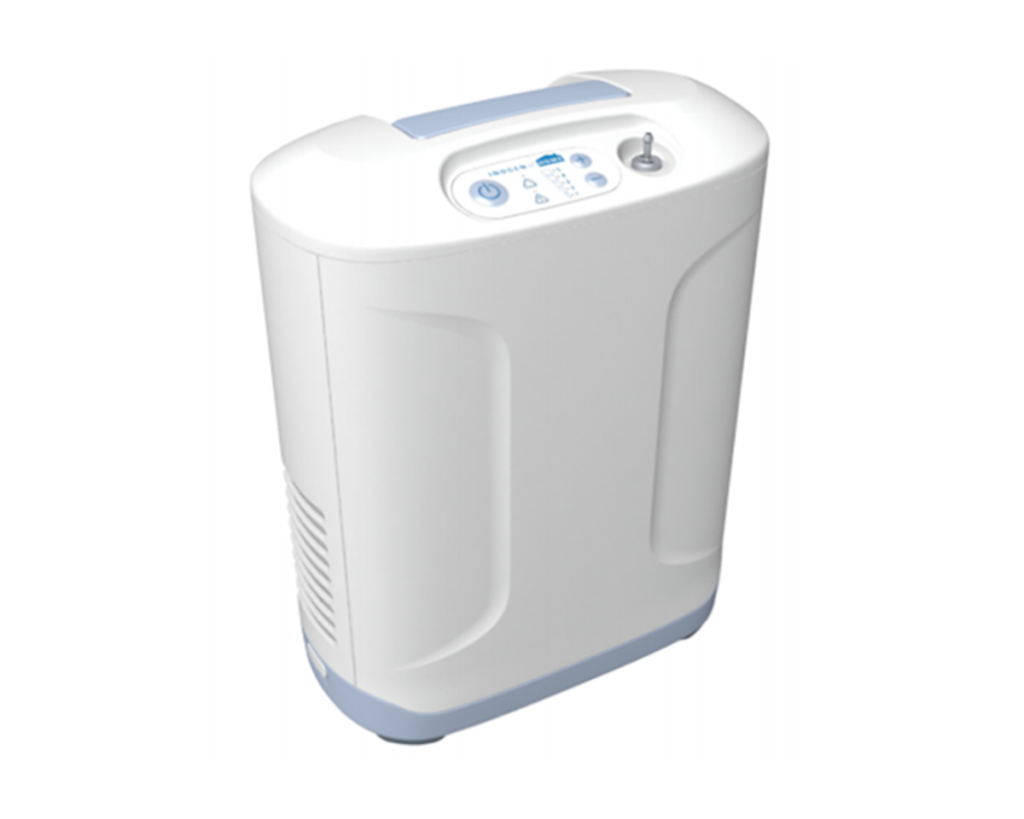
Philips Respironics EverFlo Q Oxygen Concentrator with OPI
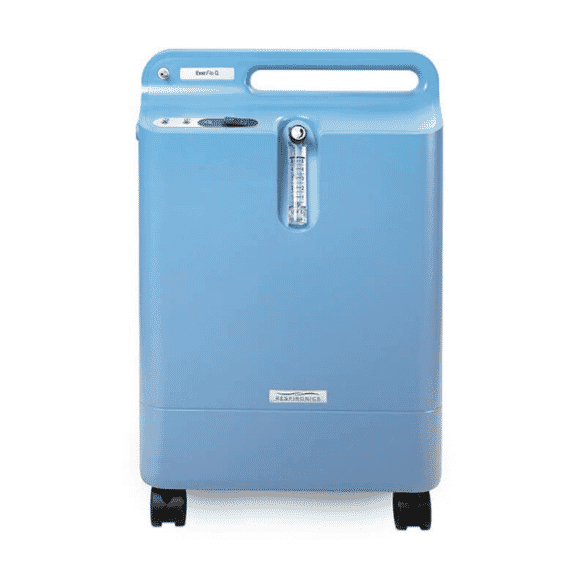
The compact 31 lb. Philips Respironics offers ultra-quiet performance for shared spaces and a compact design for smaller rooms. The Respironics stands apart with its distinctive Oxygen Purity Indicator (OPI), measuring the oxygen output for purity levels, which provides peace of mind.
At The Oxygen Concentrator Supplies Shop, our trained team can offer assistance in answering questions and helping you pick the right home oxygen concentrator that best suits your needs. Give us a call at 888.941.1688.
Reference:
- MedlinePlus. Lung Diseases. Accessed September 2019.
What is a Home Oxygen Concentrator?
During a typical day, the average person breathes nearly 25,000 times¹ without thinking much about it. But, not everyone is breathing easy. For those suffering from respiratory ailments that require a regular supply of supplemental oxygen, each breath matters. A home oxygen concentrator (HOC) is the preferred solution for delivering that necessary flow of oxygen in the comfort of your own home. With a home oxygen concentrator, you no longer need tank refills or replacement oxygen tanks. HOCs are an effective alternative to providing oxygen more easily and more comfortably.
How Does a Home Oxygen Concentrator Work?
HOCs do not require a supply of oxygen. Instead, they convert the air in your home into oxygen. Air is taken in and compressed. The HOC removes nitrogen, then pure oxygen is delivered through a mask, or an oxygen delivery device called a nasal cannula. Home oxygen concentrators are for stationary oxygen treatment at home and need electricity from a wall socket
Who Needs a Home Oxygen Concentrator?
HOCs are recommended by doctors when the level of oxygen in your blood is low. HOCs may be used for short-term treatments in conditions like asthma or pneumonia or for long-term care for chronic conditions like COPD.
Benefits of an Oxygen Concentrator
There are many benefits to using an oxygen concentrator, including:
- Enhanced stamina: You will be able to sustain longer periods of physical activity or mental effort.
- Easier breathing: An oxygen concentrator will give you the extra oxygen your body needs to breathe easier and better.
- Increased exercise ability: You will be able to better exert yourself and remain active longer.
- Better sleep: Getting the proper treatment you need will result in healthier and better sleep.
- Better overall health: The extra oxygen in your body helps reduce the risk of other illnesses.
- Greater independence: A portable oxygen concentrator allows users to be on the go while receiving oxygen therapy.
How To Use An Oxygen Concentrator At Home?
When you purchase an oxygen concentrator, a user guide will also come with it. Read that manual to learn how to use and maintain it. Additionally, your healthcare provider will be able to help you set the oxygen flow rate that they prescribe you to and explain other settings.
There are additional optional items you can purchase to enhance your oxygen therapy experience. These include:
- Long-length Tubing: Using longer tubing will provide more freedom of movement around the house. You can extend the tube that runs from the machine to your nose by up to 50 feet with a hose attachment. However, if you choose to use long tubing, be careful not to trip on the hose while you walk around.
- Humidifier Bottle: If the supplemental oxygen you are receiving dries out your nose, you may be able to attach a humidifier bottle to the unit. You fill it with distilled water, and it makes the oxygen you breathe in more moist and comfortable.
How Many Hours Do Home Oxygen Concentrators Last?
On average, a single-battery oxygen concentrator lasts from two to six hours. The average double-battery oxygen concentrator can last between five and 13 hours. A home oxygen concentrator that plugs into a wall out will run as long as you have power in your home.
Oxygen Concentrator Cleaning
- Tubing: Wash your tubing once a week with warm water and mild dish soap. Clean it more often if you get sick to eliminate any germs. Allow the tubing to air dry completely before using it again, and don’t let water get in the tube. If the tubing looks damaged, get a replacement as soon as possible to ensure optimal performance.
- Humidifier Bottle: Clean your humidifier bottle every 3 days with warm water and mild dish soap. Rinse it with hot water to make sure it is fully cleaned. You can also soak it in a mix of vinegar and water for a few minutes to clear out any leftover bacteria. Dry the bottle with a paper towel, then air dry it before using it again for your oxygen therapy.
- Concentrator Filter: The filter within your concentrator should be cleaned at least once a month. Take it out from your machine and wash it with water and mild dish soap. Scrub with a washcloth to get rid of any dirt or dust, then rinse it under water to remove any soap residue. Lay the filter on a dry, clean towel and let it air dry completely before you put it back in the concentrator.
Choosing a Home Oxygen Concentrator
With so many options of HOCs available, the best place to start when selecting a home oxygen concentrator is by asking yourself a few simple questions.
How much oxygen do you need?
Some respiratory conditions may require a high capacity flow of oxygen up to 10LPM (liters per minute). In other instances, a lower LPM may be enough. Your doctor’s prescription will determine the LPM you need.
What size home oxygen concentrator should you get?
If home space is limited, consider a more compact HOC. These models are more lightweight, weighing as little as 18 lbs. Often set on casters for effortless mobility, individuals can easily move the HOC by themselves. However, if you travel frequently, you may want to consider a portable oxygen concentrator.
Are HOCs easy to use?
You want a home oxygen concentrator that isn’t complicated. Look for designs that feature a simple and easy-to-understand control panel. Energy efficiency and quiet performance are also essential features if you use your HOC often.
When you need an LPM between 1 and 5, two lightweight, easy-to-use models stand out.
Popular Home Oxygen Concentrators
Inogen at Home
The Inogen at Home Oxygen Concentrator is one of the most energy-efficient, lightest, and quietest oxygen concentrators on the market today. weighing only 18 pounds, the Inogen at Homr is an ideal home unit. The Inogen delivers up to 5 LPM of continuous flow oxygen at low power, so it saves on the electric bill. It has a user-friendly interface, large control panel buttons, quiet operation, and more.
Drive Devilbiss 5 Liter| 525DS
The Drive DeVilbiss 5-liter oxygen concentrator - 525DS is a portable, easy-to-use home oxygen concentrator that offers continuous oxygen flow rates of up to 5 liters per minute (LPM). The DeVilbiss 525DS oxygen concentrator has wheel bearings with smooth flow and an easy-access grip on the sides and top of the device. The user will immediately be informed of any alerts or the current operating condition by four indicator lights on the front panel. There is also a built-in shelf for a humidification bottle and an easily readable flow meter with a flow control dial.
Caire Companion 5
The Caire Companion 5 can produce up to 5 liters of oxygen per minute (LPM). Its ultraSILENT Technology and straightforward user interface make it an ideal choice for patients. It features a one-touch On/Off button for simple operation. The Caire Companion 5 is 40 dBA at 2 LPM, which is about as loud as a calm library. To notify users of any operating concerns, the control panel has LED indicators, a flow control knob, and loud alarms. Intake noise is muffled by a sophisticated combination of an intake filter and a two-chamber muffler.
Conclusion
At The Oxygen Concentrator Supplies Shop, our trained team can offer assistance in answering questions and helping you pick the right home oxygen concentrator that best suits your needs. Give us a call at 888.941.1688.
Reference:
MedlinePlus. Lung Diseases. Accessed September 2019.



